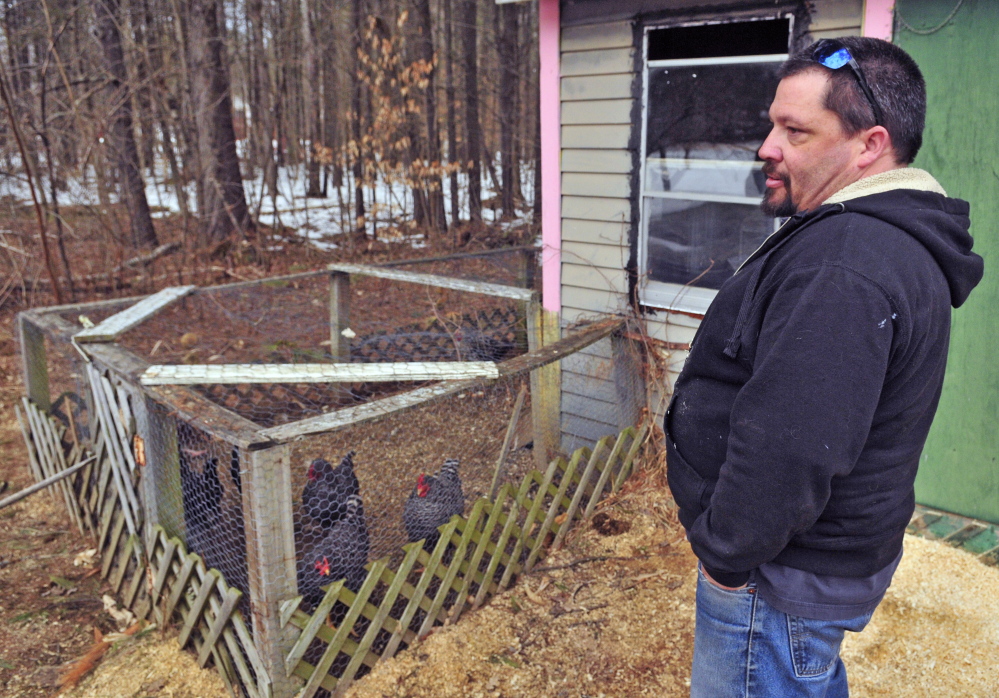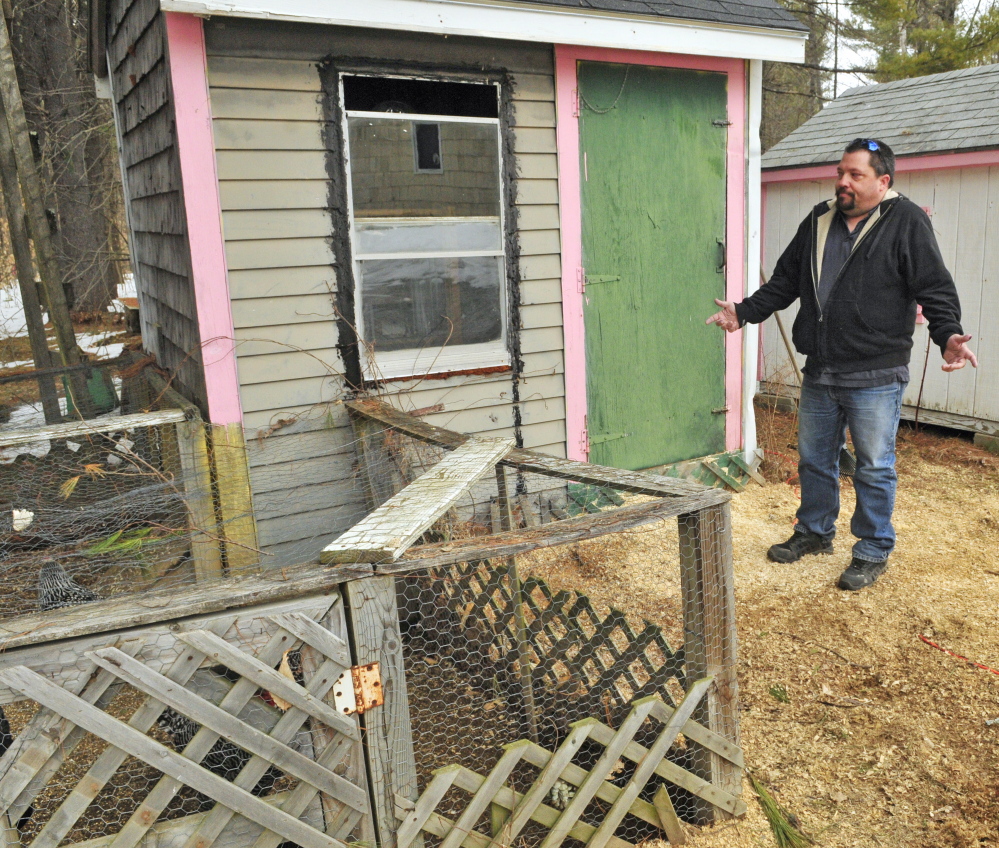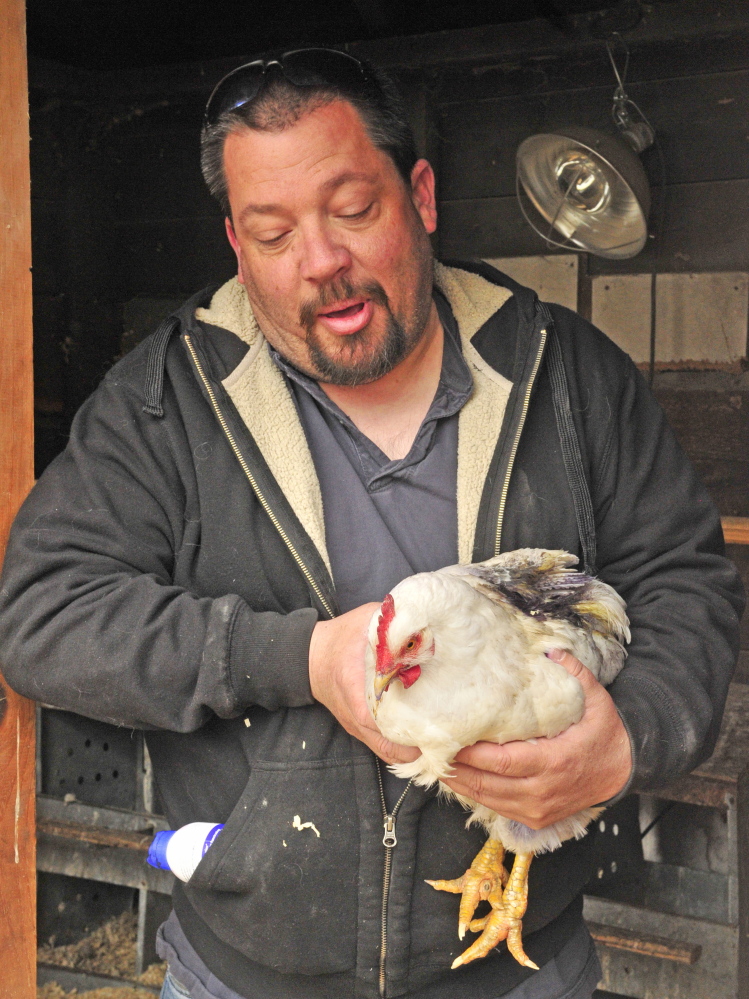LITCHFIELD — Henry Tuttle’s laying hens have been known to follow him around his yard, like clucking lemmings following their bearded leader. On occasion those strolls have led right through the front door of Tuttle’s house.
“They’re my pets,” Tuttle said of the birds that supply him a healthy number of eggs and a seemingly endless supply of satisfaction.
Tuttle is keeping an even closer eye over his flock these days and wonders how much longer he’ll have Big Girl, the hen at the top of the pecking order. She and Crazy, her second-in-command, were recently mauled by a beagle that sneaked into their coop and managed to take several ounces of feathers and flesh from the birds before Tuttle could force the dog to run away. Big Girl, whom Tuttle has had for eight years, took the worst of it. Tuttle is treating her for an infection, but he doesn’t know if that will be enough.
Whether they are attacking birds, chasing deer or just making a general nuisance of themselves, roaming dogs have become an increasing problem in his Huntington Hill Road neighborhood, Tuttle said. This is the third time in as many years that domestic dogs have attacked Tuttle’s birds, and his patience is waning.
“I’ve had foxes and hawks attack them, too,” Tuttle said. “I don’t like that either, but it’s nature and I can accept that. Domestic dogs? I can’t accept that.”
Tuttle did not talk to Animal Control Officer Jeffrey Flaherty after the March 30 attack, but Tuttle said he has called animal control as well as police a handful of times in the past three years. Tuttle wonders what anyone besides the dogs’ owners can do to stop it.
“A lot of these, it’s just a hit and run attack,” he said. “They’re here and they’re gone.”
Flaherty said most of the dog complaints he gets are in more congested areas like the southern part of town. He has been the town’s animal control officer for about 18 months and has responded to only a few complaints in the Huntington Hill Road area.
Flaherty said his approach to cases is similar to that of police: He needs to build a case based on proof. That can be difficult to do when it comes to wayward dogs. Flaherty said the best evidence is a picture if someone is able to grab their cellphone camera in time.
“I can’t accuse the next door neighbor’s dog of doing something if I don’t have proof,” Flaherty said.
MORE ATTACKS
Big Girl is the only hen remaining from the original batch of hens Tuttle bought about eight years ago. He has about seven other hens that share a large shed-like coop and an outside pen surrounded on the sides and top with chicken wire. His family eats the eggs and uses them to trade for goods with a local farmer. Others are just given away.
“My neighbors haven’t had to buy eggs for seven or eight years now,” Tuttle said.
Tuttle likes to give his birds a little more freedom, however, and made a practice of letting them out of the pens to range free around his large parcel of land off Huntington Hill Road. That practice continued without incident for years until about three years ago when Tuttle said his birds were attacked by a domestic dog for the first time,
“When I first got my birds, I’d let them out all day, even when I wasn’t home,” Tuttle said.
Dogs have attacked the birds twice more in the past few years. The beagle attacked on March 30. The dog ran into the hen house door, which Tuttle had left open for the birds to roam, and began terrorizing the birds inside the pen.
“I looked out the window and saw the beagle in the coop,” Tuttle said. “The dog has literally got a mouthful of feathers.”
Tuttle came running and managed to scare the dog off, but not before it had badly injured Big Girl and Crazy.
“I’d never seen that dog before,” Tuttle said. “It seems like every time there’s an attack it’s a different dog.”
RUNNING DEER
The next night a different group of dogs turned its attention to a local deer herd. Bruce Bell, whose house is visible a short distance through the woods behind Tuttle’s house, said he was standing in his living room when he noticed a herd of about seven deer dash through a clearing across the dead-end road from his house. Two yellow Labrador retriever-type dogs, one wearing an orange collar, were close behind. Bell’s wife, Brenda, rushed out the door to yell at the dogs, which broke them off the chase, Bruce Bell said, but about 20 minutes later the dogs returned in pursuit of more deer.
Bell said a car came by shortly after, passing slowly by the house as the two people inside swiveled their heads to look around.
“My wife and I think they were looking for their dogs,” Bell said. “I’m sure their dogs just got loose.”
This is the second time Bell has seen dogs chasing deer in the past three years. Both times he has called the game warden, but the dogs and deer are always long gone by the time officers arrive.
“There’s not much anybody can do,” Bell said.
But Game Warden Kris MacCabe, who patrols the Franklin County area, said wardens are often able to identify dogs that have chased deer by following the dogs’ tracks back to the owners.
“With snow conditions right now we can track them back and typically find an owner,” MacCabe said. “The dogs are going to go very far. We can kind of narrow it down by going neighbor to neighbor. Typically what we find is if we have one person who has a complaint, we talk to a neighbor down the road and they’ve seen the same thing.”
A first-time offender will, in most cases, get off with just a warning, but subsequent violations can result in a charge of a dog chasing a deer or a dog killing a deer, which are hunting and fishing violations, or a violation for a dog at large.
“We’re the only ones that can protect the wildlife,” MacCabe said. “If we don’t take care of people’s domestic dogs, then the deer really don’t have a chance.’
Spring conditions are nearly ideal for domestic dogs to chase deer because the snow is melting, but the pack is hard enough for dogs to stay on top. Deer are beginning to come out of their winter yards and move around more, MacCabe said. This also is the time of year that females are carrying unborn fawns.
“Domestic dogs are one of our biggest issues this time of year,” he said. “Even if people don’t think their dog can take down a deer, it’s illegal for them to chase it because the doe is going to abort the fawn because of the stress of being chased.”
MacCabe said it is especially important for people to keep control of their dogs this spring because the deer have already struggled through a hard winter with heavy snow.
“We’re trying to give the deer the best shot we can,” he said. “We really try to control domestic dogs getting into these deer yards because they can really put a hurting on a population of deer.”
Flaherty, the animal control officer, said the worst thing people can do is remain silent. Even if there is no picture, he said he wants to hear from people who are seeing dogs roaming free.
“A lot of people won’t say anything,” Flaherty said. “I think it’s just an old way of thinking. If someone sees a dog in a field carrying a chicken, it’s just a loss.”
Tuttle said he sees a free dog about once a month, but typically does not call authorities. He has three dogs of his own. He understands that dogs can sometime get free.
“Even the best dog owners and the best dogs, it’s going to happen occasionally,” Tuttle said. “It’s just happening way too often.”
Send questions/comments to the editors.





Comments are no longer available on this story